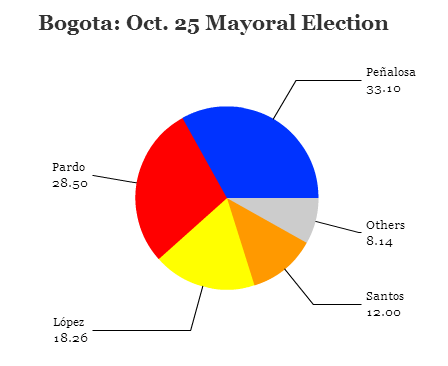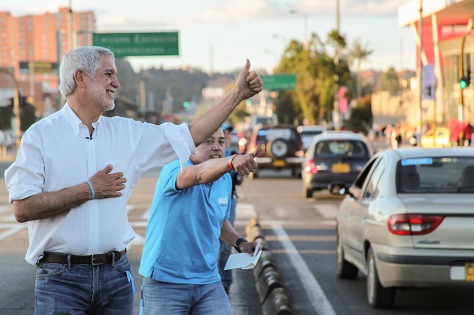After a disappointing fifth-place finish in last year’s presidential election, former Bogotá mayor Enrique Peñalosa has made a staggering political comeback, winning a new term as the mayor of Colombia’s capital 14 years after first serving in the office.![]()
Peñalosa was widely expected to win the race, the most high-profile in a series of local elections across Colombia on October 25, which come at a crucial point in ongoing negotiations between the government of president Juan Manuel Santos and the guerrilla Fuerzas Armadas Revolucionarias de Colombia (FARC, the Revolutionary Armed Forces of Colombia).

Peñalosa, formerly a member of Colombia’s moderate/liberal Partido Verde (Green Party), ran as an independent campaign in the current Bogotá race, though he did so with the support of a minor center-right party, Cambio Radical (Radical Change). Despite his ties to the Greens, Peñalosa has always been a relatively business-friendly figure in Colombian politics with both economically and socially liberal policy positions. In his first stint as mayor, he introduced TransMilenio, the city’s rapid transit bus system.
Despite his past electoral failures, Peñalosa’s victory gives him access to a position that’s more powerful than any other in Colombia (with the exception of the presidency). He should now be seen a serious potential contender for the Colombian presidency in 2018, when term limits will force Santos to step down after two terms in office.
Peñalosa narrowly defeated Rafael Pardo, the candidate of Santos’s centrist Partido Social de Unidad Nacional (Social Party of National Unity, known widely as the ‘Party of the U’). Formerly a minister of national defence in the early 1990s, under former president César Gaviria, Pardo was one of the key players who helped end the reign of Pablo Escobar’s Medellín cartel. Pardo, who ran for the presidency in 2010 but who now supports Santos, currently serves as Colombia’s labor minister.
Clara López, a left-wing candidate who also contested the presidency in 2014, finished in third place.
Francisco Santos, a cousin of the current president and a former vice president, finished in fourth place as the candidate of the right-wing Centro Democrático (Democratic Center), the party of former president Álvaro Uribe, who broke bitterly with Juan Manuel Santos over the FARC negotiations.
Peñalosa was the first of a troika of Bogotá mayors widely given credit for improving the city’s transportation, infrastructure and livability. His two successors, Antanas Mockus and Luis Eduardo Garzón, carried forward Peñalosa’s technocratic zeal for using urban planning as a tool for economic growth, welfare and social justice.
In 2008, Bogotá’s electorate turned left, electing the more hardline leftist Samuel Moreno, who was ultimately removed from office in 2011 and arrested on corruption charges stemming from irregularities in granting public contracts. In 2011, Peñalosa attempted a comeback to city politics, but he lost to Gustavo Petro, another radical leftist and a former M-19 rebel leader, as Bogotá’s mayor. In 2013 and 2014, Petro struggled with Colombia’s courts, which originally ordered Petro’s removal from the mayor’s office, tangentially over the collection of the city’s garbage. Nevertheless, the attempt to oust Petro was more widely seen as a bid by Colombia’s right-wing conservatives to de-legitimize the role of former guerrilla rebels in Colombia’s politics.

Hi,
A number of mistakes here:
1. Cambio Radical is not a minor centre-right party, it is the party of vice president Germán Vargas Lleras, quasi-certain to run for president in 2018 and therefore using last October’s elections as the groundwork for a national campaign. Endorsing Peñalosa was a major part of that.
2. Peñalosa’s victory does not make him a likely presidential candidate in 2018, he is rarely even mentioned as a potential presidential contender by the media. Vargas Lleras likely endorsed him with the expectation that Peñalosa will return the favour in 2018.
3. Rafael Pardo is not labour minister and hasn’t been labour minister for nearly 2 years now (June 2014). He is not either from the Partido de la U, but rather from the Liberal Party, although his candidacy was also supported by the U.
4. Bogotá ‘turned to the left’ in 2003, not 2008, with the victory of ‘Lucho’ Garzón in the 2003 mayoral elections.
5. Calling Moreno or Petro ‘radical leftists’ is editorializing. Moreno is the grandson of Gustavo Rojas Pinilla, who was many things but certainly not a radical leftist; and by consequence, Moreno, who made his political début with Rojas Pinilla’s ANAPO. Petro is a greyer case, because of his guerrilla roots, but M-19 was never known for doctrinaire Marxism or anything of that kind (especially considering the roots of M-19). Regardless, Petro was never shy about attacking the dogmatism of some on the left or highlighting the FARC sympathies of a limited number of elected politicians. In fact, Petro owed his 2011 victory in Bogotá to running a hard campaign against corruption, i.e. against Moreno.